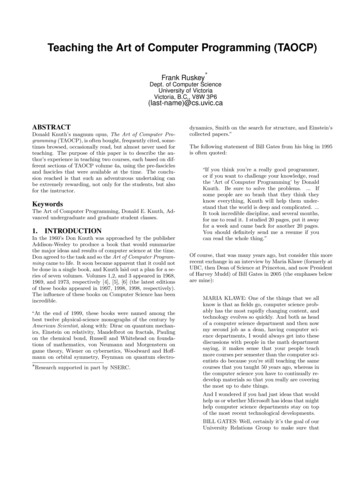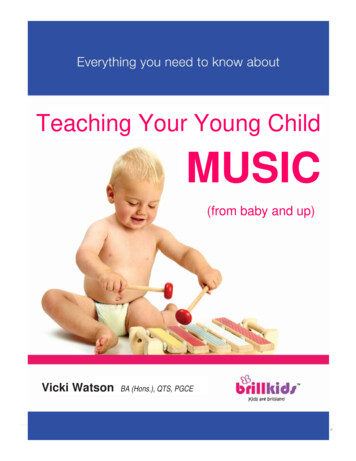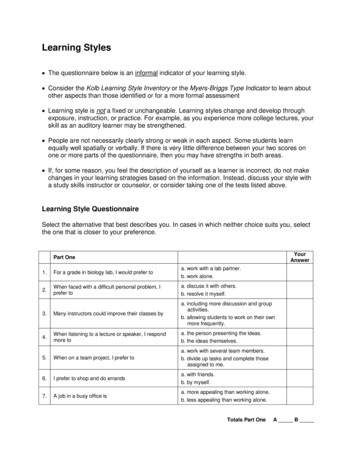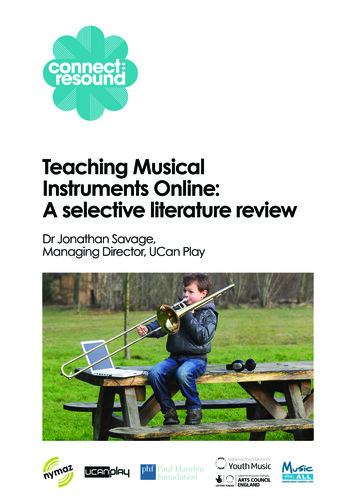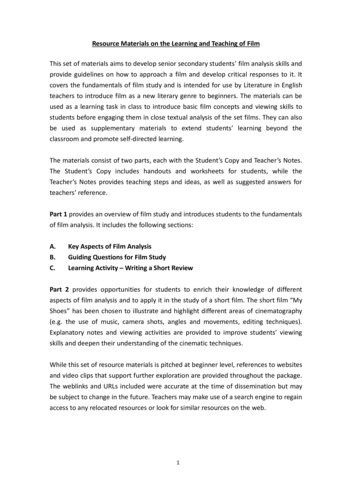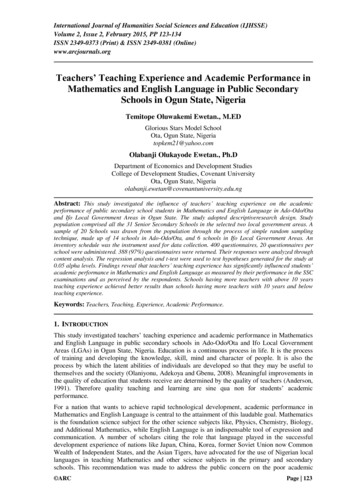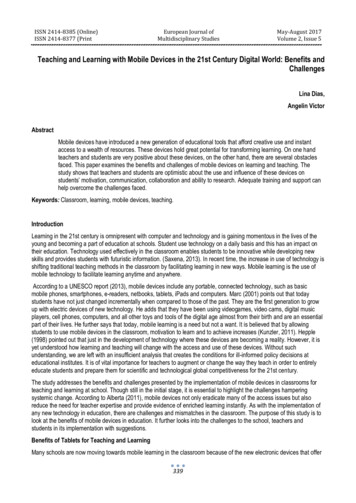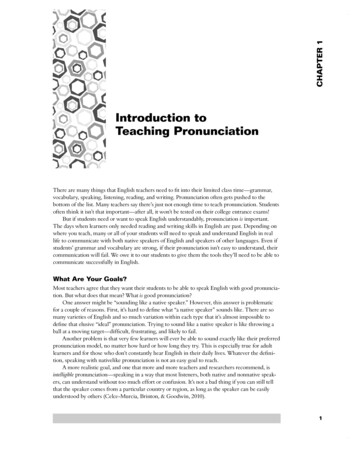
Transcription
CHAPTER 1Introduction toTeaching PronunciationThere are many things that English teachers need to fit into their limited class time—grammar,vocabulary, speaking, listening, reading, and writing. Pronunciation often gets pushed to thebottom of the list. Many teachers say there’s just not enough time to teach pronunciation. Studentsoften think it isn’t that important—after all, it won’t be tested on their college entrance exams!But if students need or want to speak English understandably, pronunciation is important.The days when learners only needed reading and writing skills in English are past. Depending onwhere you teach, many or all of your students will need to speak and understand English in reallife to communicate with both native speakers of English and speakers of other languages. Even ifstudents’ grammar and vocabulary are strong, if their pronunciation isn’t easy to understand, theircommunication will fail. We owe it to our students to give them the tools they’ll need to be able tocommunicate successfully in English.What Are Your Goals?Most teachers agree that they want their students to be able to speak English with good pronunciation. But what does that mean? What is good pronunciation?One answer might be “sounding like a native speaker.” However, this answer is problematicfor a couple of reasons. First, it’s hard to define what “a native speaker” sounds like. There are somany varieties of English and so much variation within each type that it’s almost impossible todefine that elusive “ideal” pronunciation. Trying to sound like a native speaker is like throwing aball at a moving target—difficult, frustrating, and likely to fail.Another problem is that very few learners will ever be able to sound exactly like their preferredpronunciation model, no matter how hard or how long they try. This is especially true for adultlearners and for those who don’t constantly hear English in their daily lives. Whatever the definition, speaking with nativelike pronunciation is not an easy goal to reach.A more realistic goal, and one that more and more teachers and researchers recommend, isintelligible pronunciation—speaking in a way that most listeners, both native and nonnative speakers, can understand without too much effort or confusion. It’s not a bad thing if you can still tellthat the speaker comes from a particular country or region, as long as the speaker can be easilyunderstood by others (Celce-Murcia, Brinton, & Goodwin, 2010).1
Still, while it’s not practical to set our goal impossibly high, we also can’t afford to set it toolow. It’s not helpful for students to become too complacent and to believe that their pronunciationis fine when, in fact, it may not be easily understood by anyone other than their own teacher andclassmates. To be truly intelligible to a wide range of listeners, and not just to willing listeners oftheir own language background, speakers need to come fairly close to some kind of a recognizedstandard, whether it’s one of the major native-speaker varieties or a nonnative variety of pronunciation that is easily understood by listeners from many backgrounds. As responsible teachers, wemust make sure we don’t set the bar too low.We should also realize that English teachers, both native and nonnative speakers, are often notthe best judges of whether someone’s pronunciation is intelligible. Many English as a secondlanguage (ESL) or English as a foreign language (EFL) teachers can understand their students’speech when people in the wider world can’t; in fact, it sometimes seems that we teachers canunderstand practically anything. We’re used to inaccurate pronunciation. We know what studentsare going through and how hard they’re trying. We’re on their side and want to understand them,while a future employer or a cashier at Starbucks might not try so hard. Nonteachers are a toughaudience (Lane, 2010).Accuracy and FluencyWe often think of pronunciation teaching in terms of helping students achieve accurate pronunciation so that their production of sounds, stress, rhythm, and intonation begins to match an idealpattern. But accuracy is only one part of good pronunciation. Fluency in producing sounds andother aspects of pronunciation is equally important. The two don’t always go together. For example, many students learn to produce a new sound correctly when they’re concentrating carefullyand saying it alone or in a single word. When they need to use that same sound in conversation,however, it’s much more difficult to keep producing it correctly—they can’t pronounce the soundfluently. After all, in real-world speaking, pronunciation is just one among many things that students have to think about. Vocabulary, grammar, the ideas they want to express, and the appropriate degree of politeness and formality also occupy their attention.It’s hard to use pronunciation accurately and fluently at the same time. Because of this, whenwe’re practicing pronunciation, we should include some activities that emphasize pronunciationfluency—speaking smoothly and easily, even if not all the sounds are perfect—along with activitiesthat emphasize accuracy—producing sounds correctly. Both accuracy and fluency are important inpronunciation, just as they are in speaking in general, and both deserve attention and practice.Trends in Teaching Pronunciation: The Pendulum SwingsOver the years, styles of language teaching have changed greatly,and the same is true of teaching pronunciation. In some timeperiods, teaching pronunciation has been considered extremelyimportant, while at other times it hasn’t been given much attention at all. Trends in teaching pronunciation are like a swingingpendulum—the emphasis goes from one extreme to the other.Until recently, the focus in pronunciation teaching wasalmost entirely on producing individual sounds and wordscorrectly; not much attention was given to features such asFigure 1.1. Pendulum.intonation and rhythm. (You’ll read about these things inChapters 8 to 12.) In the last 20 years or so, however, teachersand researchers have begun to realize the importance of these“musical” aspects of pronunciation and to emphasize them more strongly in teaching (Celce- Murcia et al., 2010; Goodwin, 2001). Some scholars have gone so far as to claim that teaching2Beyond Repeat After Me: Teaching Pronunciation to English Learners
individual sounds is not so important, and intonation, stress, prominence, and rhythm should beemphasized above all (Lane, 2010; Celce-Murcia et al., 2010; Gilbert, 2008).It seems more practical, though, to realize that no single aspect of pronunciation can standon its own. Our students can benefit from learning about both individual sounds and the musicalaspects of pronunciation, and we need to find a balance between these two areas. The pendulum ofteaching trends might keep swinging, but we don’t have to let it knock us down. Choose methodsand activities that combine both aspects of pronunciation so that the combination works best foryou and your students. (For a more complete discussion of the history of pronunciation teachingmethods, see Celce-Murcia et al., 2010, Chapter 1.)What Affects Pronunciation Learning?Many things contribute to learning pronunciation, from students’ ages, motivation, and personality—which depend on the learners themselves—to the quality of the teaching and the students’first language—which are outside factors.The Age of the LearnerWe’ve all observed how easily babies and very young children learn languages. They just seemto absorb the sounds and words they hear around them and, little by little, learn to imitate themaccurately. Linguists call this time in a child’s life, lasting up to the age of about 12 to 14 years,the critical period for language acquisition. Children can learn the sounds of language morenaturally than adults and can approach native speaker pronunciation, but only if they are surrounded by the language and have many chances to hear its pronunciation. Young children whohear English only a couple of hours a week lose much of their learning advantage.Effective pronunciation learning is not limited to young children, however. Older children andadults have their own strengths and can also learn pronunciation well, even if they never soundquite like native speakers. Adults are better able to set goals and to practice purposefully. They canunderstand more abstract explanations and analyze how sounds are produced and how the melodyand rhythm of a language sound. Adults should not give up the hope of having easily intelligiblepronunciation; they just have to reach their goal in a different way than children.MotivationLearners in any subject area tend to make more progress if they want to learn. No teacher can forcestudents to learn if they’re not motivated. A proverb says, “You can lead a horse to water, but youcan’t make him drink.” This also applies to teaching pronunciation. We can provide informationand many chances to practice, but we don’t have the power to change our students’ pronunciationfor them. They have to want to do it and be willing to do the work themselves.Three general sets of goals or desires have been suggested that can motivate students in language learning (Celce-Murcia et al., 2010, p. 21): Learners want to be accepted into a group that uses the language. The group might stillrecognize the learners as “outsiders,” but they can function well in the group. This is sometimes called integrative motivation. They want to be accepted as real members of the group. They don’t want to be thought ofas “outsiders.” This is called assimilative motivation. They want to be able to use the language to reach a goal: To get a job, to conduct business, to pass a test, or to travel easily in a foreign country. This is called instrumentalmotivation.If we recognize our students’ goals in learning English, we can help motivate them by showingthem how improving their pronunciation will help them reach their goals.Introduction to Teaching Pronunciation3
Personality and AptitudeNo two people are alike. We each have our own personality, talents, strengths, and weaknesses.These factors can affect how people learn pronunciation.Teachers sometimes assume that more outgoing learners will be able to learn pronunciationbetter than shyer students, and there may be some truth to this. Confident students might speakmore and be more willing to try new sounds, and this extra practice could help them improve theirpronunciation. However, this improvement is certainly not guaranteed. Some outgoing studentsmay be producing a lot of language, but they may also be jumping ahead without paying attentionto the accuracy of their pronunciation. If listeners are impressed by their fluency and accept theirimperfect pronunciation, they have no way to know that they need to improve.Some more introverted students might actually be thinking carefully about sounds and practicing “within themselves,” even if they don’t speak much in class. Don’t underestimate the quietstudents. Appreciate the strengths and possibilities of all your students, and encourage everyone.All students can learn and improve in their own way.Another aspect of personality that can affect pronunciation is the degree to which a person iswilling or able to change the way he or she sounds. Most of us have been speaking and listening tolanguage in the same, familiar way since we learned to talk. Our voice and our pronunciation area central part of the way we see ourselves. It can be uncomfortable, and possibly even frightening,to try out unfamiliar sounds and melodies of language. For some people this process seems like asmall bump in the road, but for others, it’s a serious roadblock.Finally, some people seem to have more of an aptitude or talent for learning language orimitating pronunciation than others. We say that some people “have a good ear” for language. Ofcourse, this is something that is almost impossible to define or measure. What seems like a naturaltalent may be partly due to special motivation, encouragement from parents or teachers, or growing up in an environment where there are many opportunities to hear and learn other languages.In fact, there’s no magical ability possessed by some people but not others that determines whethersomeone can be a successful language learner. As teachers, we need to believe that everyone hasan ability to learn pronunciation. Then we need to give all our students the help they need to doit well.Methods and Quality of TeachingSo far I’ve discussed factors that depend on the learners themselves, but there are also outsidefactors that affect pronunciation learning. The kind of teaching students have experienced, both inamount and quality, has a strong influence on their learning. Have they received a lot of trainingin pronunciation, only a little, or perhaps almost none at all? How much practice have they had?Was it effective practice using a variety of activities or entirely “repeat after me” without effectivefeedback from the teacher? Were the teachers interested in pronunciation, or did they consider it tobe only unnecessary fluff? Is it even possible that their past teachers have given them false information or provided an extremely inaccurate model? The quality of teaching that students receivecertainly affects the quality of their learning.Exposure to the Target LanguageStudents’ pronunciation learning is also affected by how much English they have a chance to hearin their daily lives. Learners who live in an English-speaking country where they are constantlysurrounded by the language will be more familiar with the sounds and melodies they’re trying toimitate than those who have few chances to hear spoken English—perhaps only during Englishclasses for a few hours each week.4Beyond Repeat After Me: Teaching Pronunciation to English Learners
The Influence of the Learner’s LanguageA learner’s first language (often referred to as the L1) has a strong influence on the way he or shelearns the pronunciation of a second language (referred to as the L2). Often this influence is helpful,such as when some sounds are very similar in the two languages. For example, knowing how topronounce /m/ in one language makes it easy for a learner to pronounce /m/ in another language.However, learners’ pronunciation habits in their first language can also make it more difficultfor them to pronounce sounds in the new language that don’t exist in their L1 or that are used in adifferent way. This influence is called native language interference or language transfer.Effects of Differences BetweenFirst Language and Second LanguageWhat happens when learners hear and try to pronounce strange, new sounds in a new language?These types of problems often occur:Merging. When learners hear unfamiliar sounds in a new language, they tend to interpretthe sounds of the new language in terms of the categories of their original language. The learner’sbrain may hear two sounds as being the same when they’re actually considered separate sounds inthe new language. This is called merging and leads to pronunciation errors. When our brains andears can’t tell the difference between two similar sounds, we tend to pronounce both of them inthe same way. For example, many languages don’t have separate vowel sounds like the ones in reach(/iy/) and rich (/ɪ/). Speakers of these languages may merge the two sounds and pronounce themboth in the same way.Substitution. When learners hear a new sound that doesn’t match any of the sounds theyknow, they often substitute a familiar sound that is somewhat similar and easier for them toproduce. For example, the first sound in think and three is found in relatively few languages in theworld. Speakers of languages that don’t have this sound often substitute /s/, /f/, or /t/ so that thinksounds like sink, fink, or tink.The effect on intelligibility. The processes of substitution and merging can cause seriousproblems for learners’ intelligibility. When listeners expect to hear one sound but actually hear adifferent one, communication can break down. Even when teachers make learners aware of what’shappening, it’s difficult not to fall into one of these traps.Problems with Individual WordsSo far we’ve been thinking about pronunciation problems that are very general—they affect all thewords with a particular sound or combination of sounds. However, sometimes specific words cancause pronunciation problems. Two causes of this are described here.Spelling. English has many words with irregular or unpredictable spellings, and this can leadstudents to mispronounce those words. For example, if students learn the words rain, plain, andmaintain, they will naturally assume that the letters ain must represent /eyn/. Then if they see thewritten word mountain, they may mistakenly pronounce it /mawnteyn/. Since students often meetwords first in their written form, this can lead to incorrect pronunciation of many words.Borrowed words. Many languages have borrowed words from English, adapting theirpronunciation to fit the sound system of the borrowing language. (Sometimes the meanings of thewords have also changed, but that’s a separate issue.) For example, Table 1.1 shows some Japanesewords borrowed from English and the sound changes they’ve undergone in the process.We might think that knowing words that have been borrowed from English into the student’snative language would make it easier to learn those words in English, and this is often true withword meanings. However, familiarity with these borrowed words can actually make it harder forlearners to pronounce the words correctly in English if they assume that the pronunciation is theIntroduction to Teaching Pronunciation5
Table 1.1. Japanese words borrowed from English.Comes from thisEnglish wordJapanese wordMain sound changesジュース/ʤuusu/juice/ʤuws/Extra vowel is added after final consonant.ガラス/garasu/glass (the material)/ɡlæs/Extra vowel is added to split up consonant cluster. Extravowel is added after final consonant. /l/ is replaced by /r/.Main vowel sound becomes /a/ instead of bɚɡɚ/First vowel becomes /a/ instead of /æ/. In second andthird syllables /ɚ/ becomes /aa/.same in English as it is in their native language. This can cause misunderstandings. In an ESL classthat I observed recently, the teacher asked a Japanese student about his favorite food. The studentanswered: /karee/. (The last vowel is similar to the vowel in bed, not need.) The teacher had no ideawhat the student meant, and it took several tries by the student and his classmates until the teacherrecognized the word as curry, which in American English sounds like /ˈkəriy/. Teachers need totake special care to point out and practice words that are pronounced differently in English thantheir borrowed counterparts.FossilizationOne of the most stubborn problems that we face in teaching pronunciation is fossilization.Fossilization is a process that occurs when a language learner progresses to a certain point but thenhas a hard time making further progress. For example, a student who has been studying Englishfor many years might still not be able to differentiate /v/ as in very and /b/ as in berry; this error justseems to have become a permanent part of the person’s English.When students begin to learn a new language, they usually feel like they’re making progressfairly quickly. Since they’re starting from zero, any new knowledge feels like a great step forward.But after a while, students may find that their teacher and classmates understand them when theysay /b/ instead of /v/, and so they lose their incentive for trying to say /v/ accurately. Their habit ofsaying /b/ for /v/ seems frozen in time, like a fossil of an ancient animal. Their mistake has becomefossilized, and at this point, it becomes very hard to change.Most students who have been learning English for a while have some fossilized pronunciationsthat are very hard to change or improve. So what can the teacher do to help crack up those fossils?First, we have to recognize the fossilized forms and help students realize what error they’remaking and why it’s causing a problem in understanding. Next, the learner has to be willing to putlots of effort into changing his or her pronunciation. It won’t happen easily, and it won’t happenat all if the student doesn’t work at it. We need to provide information, opportunities for focusedpractice, and feedback to the learner on how well his or her pronunciation is reaching the goal. It’sdifficult to change fossilized pronunciation, but it’s not impossible.A more effective strategy in the long run is to try to prevent fossilization in the first place.Emphasize pronunciation at all levels of teaching, especially for beginners. It’s easier to get learnersstarted on the right path than to try to change their fossilized pronunciation later.HypercorrectionA less common pronunciation problem is hypercorrection, which means “too much correction.”This happens when a student has learned a rule and tries to apply it, but applies it in too manycases. For example, a common error among Korean learners is to substitute /p/ for /f/, since /f/6Beyond Repeat After Me: Teaching Pronunciation to English Learners
doesn’t exist in the Korean language. The predictable error is to say pan instead of fan or punnyinstead of funny. But sometimes a learner has been concentrating so hard on not saying /p/—onsaying /f/ instead—that he or she sometimes says /f/ even when the correct sound actually shouldhave been /p/. The speaker might say fan instead of pan.Hypercorrection is a much less frequent and less serious source of error than fossilization—more like an occasional slip of the tongue than a long-term problem.Learning to HearBeing able to hear the difference between sounds in a new language is as important as beingable to produce the sounds. However, hearing new sounds is not always easy. How we as adultshear sounds is a result of the way we’ve become used to hearing and classifying them in our ownlanguage. We don’t “hear” and pay attention to all the speech sounds that come into our ears—only the ones that we’re used to hearing.When we were babies just learning our first language, our brains were ready to hear andaccept the sounds of any language. Babies are talented that way. But as we grew up and becamemore firmly anchored in our own language, we got used to paying attention only to the soundswe needed to hear—the sounds of our own language that we heard around us every day. Wedidn’t need to understand any other sounds, so our brains never built up the ability to identify andproduce them. Our brains developed a phonological filter that lets us hear the sounds of ourown language very efficiently but “filters out” and ignores unfamiliar, unnecessary sounds. Asadults, when we hear new sounds, it’s difficult to identify or understand them—we’re still hearingthrough the filter of our first language.To pronounce a new language well, we need to learn to hear again. We have to remove thefilter that’s hiding some of those new sounds so that our brains can hear, accept, analyze, and getready to imitate them. The first step in doing this is to be aware of the filter and deliberately tryto get past it. The next, ongoing step is to build up our awareness of new sounds, to pay closeattention to what we hear, and to imitate the new sounds until we can do it accurately. We need topractice hearing sounds well, just as we need to practice pronouncing them well.I sometimes tell students that to learn pronunciation well, they need to hear with their mouthsand speak with their ears. That is, when they listen, they think to themselves, “How would I movemy mouth to make that same sound? Where would I put my tongue and lips?” According to phonologist Peter Ladefoged (2006, p. 110), “It seems as if listeners sometimes perceive an utteranceby reference to their own motor activities. When we listen to speech, we may be considering, insome way, what we would have to do in order to make similar sounds” (p. 110). The other side ofthis idea is that when we speak, we should constantly listen to what we’re saying and compare itto what we know it should sound like. We monitor and self-correct our own pronunciation, usingour ears to give feedback to our mouths about what we’re doing right or wrong and what needs tobe changed.Feelings That Can Stand in the WayLearners’ feelings about language and pronunciation sometimes make it harder for them to developaccurate pronunciation, especially for students who don’t have a choice about learning English.For example, junior high or high school students in EFL settings are sometimes reluctant to seemdifferent from their peers by using new, “foreign-sounding” pronunciation. It’s easier and morecomfortable to pronounce words in a way that fits their own, familiar language patterns. Theyalso may not see the point in concentrating on pronunciation. After all, English is just one schoolsubject among many, and depending on their country and culture, they may not foresee a need tospeak English in their future lives. If pronunciation isn’t tested and doesn’t count for part of theirgrade, why try?Introduction to Teaching Pronunciation7
For all of us, our voice is an important part of ourselves, and our customary pronunciationis a vital part of our voice. Throughout our lives, we’ve become used to hearing certain soundscome out of our mouths and not others. Our pronunciation has always marked us as members ofa certain language or dialect group. Changing our pronunciation can seem threatening, as if it willcause us to lose our identity as a member of our own group. It seems safer and easier not to change(Gilbert, 2008). However, if students can look at their attempts to change pronunciation as a wayof adding a new skill or a new, temporary language identity rather than replacing their originalselves, it can seem less threatening.In addition, sometimes learners can feel uncomfortable if they imitate a speaker or othermodel too exactly. They might have the feeling that the speaker will think they’re mocking them ifthey try to sound too similar. (After all, young children sometimes make fun of a friend by imitating his or her way of talking, and they might be scolded for this.) But in pronunciation practice,learners have to get over that feeling and realize that imitating someone exactly helps lead themtoward their goal. It’s a valuable skill in pronunciation learning.Learning Pronunciation Takes TimePronouncing sounds involves both our minds and our bodies. When you learn new sounds, youneed to learn to move the muscles of your mouth in new ways and change the pronunciationhabits you’ve built up all through your life. This isn’t easy, and like learning any other muscularactivity, it takes a long time. Most people can’t learn to dance or to play a musical instrumentimmediately; they have to start out slowly, practice a lot, and gradually build up speed and skill.Your mouth also needs to build up muscle memory—the ability to do something more easilyafter practicing it many times. Your muscles begin to “remember” how to move in a certain waybecause they’ve done it so often.Teaching pronunciation also takes time. As teachers, we can’t just teach something once andexpect our students to master it right away. We need to come back to the same point again andagain, giving students lots of review and continued practice.What Do Teachers Need to Know?To teach pronunciation effectively, you need several types of knowledge: You need to know the facts about pronunciation: How speakers’ mouths move when theyproduce the sounds of language, and how word stress, rhythm, connected speech, andintonation work. You need to understand and be able to predict the kinds of problems your students mighthave with pronunciation and why they happen. You need to know many ways to teach pronunciation to your students, adapting yourmethods to fit them and their needs, and helping them practice effectively to overcome anyproblems they might have (Celce-Murcia et al., 2010).You also need to know these basic principles of teaching pronunciation: Include more than just “repeat after me.” Having students listen to a recording or to theteacher’s voice and then repeat is a useful part of a pronunciation lesson, but by itself it isnot enough. Encourage students to use more than one of their senses, which is more effective anyway.We can use many different ways of learning—through sight, sound, and movement—tohelp students understand and remember better. Keep lessons practical. For most students, even adults, theory and technical explanationsare hard to understand and are easily forgotten. Simple, concrete demonstrations fol-8Beyond Repeat After Me: Teaching Pronunciation to English Learners
lowed by lots of practice produce better results. Lessons need to fit our students’ level ofunderstanding. Include communicative practice whenever possible. Students need to work toward usingtheir new pronunciation in real speech. During class, we can help them practice in activitiesthat are similar to real communication. Train students to become independent and autonomous learners. Our students won’t bewith us forever. Someday they’ll be facing pronunciation puzzles on their own. If we canhelp them build up their own skills in listening, imitating, and monitoring their own pronunciation, it will be a big help to them in their future learning.In the rest of this book, we’ll talk about all of these things and how they can make your teaching of pronunciation more engaging and effective.Introduction to Teaching Pronunciation9
to absorb the sounds and words they hear around them and, little by little, learn to imitate them accurately. Linguists call this time in a child’s life, lasting up to the age of about 12 to 14 years, the critical period for language acquisition. Childr



